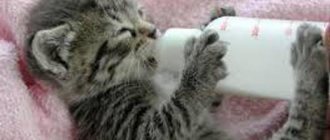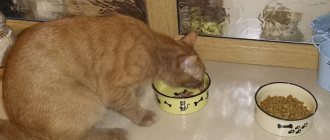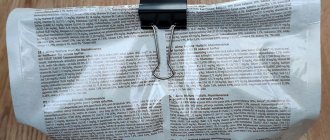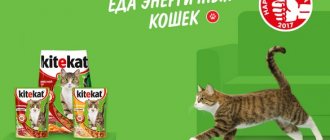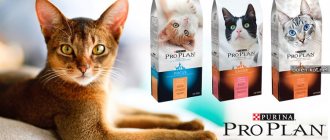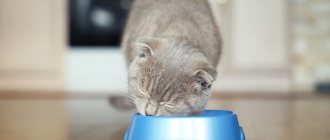Properly balanced natural feeding is the healthiest diet for cats. This is a typical diet for carnivores, which allows you to stay healthy, have a lot of energy and exercise your feeding instincts on a daily basis. In this article we will not talk about the basics of raw natural nutrition, because... this is the topic of another article. Let's talk about how to switch a cat, cat or kitten from food to meat, which is the basis of the species-typical diet.
The article is part of the Natural Cat Nutrition section. The article continues after the advertisement.
The author of the publication has the following experience on this topic:
- Transferring a Scottish Straight cat to raw meat, which was previously on boiled meat and cereals (i.e. on the so-called homemade food).
- Transfer to raw meat of a weakened three-month-old Highland Fold kitten, who previously ate Royal Canin dry food and sometimes natural products.
- Transferring a strong three-month-old Miniature Schnauzer puppy, who had previously been fed Royal Canin dry food, to raw meat.
Why doesn't a cat eat meat?
As a rule, cats love meat. Therefore, switching a cat to natural food is most often not a problem. If you give your pet a raw piece, you will see how the cat grabs the meat and greedily absorbs it, sometimes even growling. But there are opposite examples, when dried dryers have a hard time switching to a species-typical diet.
Does your cat, cat or kitten refuse to eat meat? Not surprising. He's not used to it. Try to keep a person on some foods since childhood, and then let him try exotic foods. Not everyone will like it. For example, Papuans will be shocked by the red caviar that we love so much. And we are shocked by rotten herring, which Norwegians consider a delicacy. Likewise, since childhood, a cat has only seen food: how does he know that meat is also food? But don’t worry, any predator, which is your cat, has a passion for meat. Your task is to awaken her.
But, unfortunately, it is not only because of habit that the cat does not want to eat raw meat. The second reason is that attractants are added to many foods - odor and taste enhancers, so that animals can eat any food served with a healthy nutritional sauce. Often there is almost no meat in such food, and what is available is minced meat from carrion and animals killed by euthanasia. You can read more about this topic here.
As practice shows, the cheaper the food, the more attractants it contains. Such substances are not added to high-quality feed. Therefore, an animal can happily devour Whiskas and Kitiket, but at the same time refuse good food and meat. Those. The fact that a cat eats some food but refuses other foods is not an indication that everything is fine. Cats are easy to fool with scents because... When choosing food, they are more focused on smell rather than taste. There are known cases where cats ate flavored feed, which did not contain any trace of meat.
So, the reasons why your cat refuses quality food or meat and happily eats bad food are the following: force of habit and flavorings.
Forbidden
The products presented below cannot be given during the transition to natural food, but also when the transition is finally completed.
- fatty foods, including lard;
- fried foods;
- confectionery;
- potatoes, cabbage, tomatoes;
- foods flavored with herbs or spices;
- animal bones, especially fish.
The general recommendation is not to give your pet food from the “home” table under any pretext.
How to teach a cat to eat meat?
You can talk for a long time about how to switch a cat to a natural cat. But in the end it all comes down to a few techniques. If the animal is not accustomed to eating meat, then it needs to be taught this. After all, the “factory settings” of the cat’s body are designed specifically for the consumption of meat, and not dry pads.
It is possible to train a cat to eat raw meat at any time and at any age. You need to remember this, because some animals try to prove the opposite with their behavior. As a result, the process drags on for months and ends with the owner’s capitulation.
Article continues after advertisement
Why is this happening? Because cats are cunning creatures. And domestic cats, as a rule, are also overfed. Therefore, they can afford to sort out grub and educate the owner.
Advice from “cat people”
We have collected for you the experience of people who managed to switch their pets to natural food, maybe one of the methods will suit your cat:
“Divide the daily ration of prepared food into 10 parts. On the first day, we replace one part in the morning with natural. On the second day, we replace two parts with natural food and add more and more natural food until the cat completely switches to natural food.”
“We added catnip to natural food and the cats ate it. After two weeks, they stopped adding mint - and the cats were reluctant to eat at first, but then they forgot about the ready-made food and mint and began to eat natural food.”
“You can try to trick the cat - put a few pieces of dry food on a piece of meat so that the food has a familiar smell.”
How to train a cat to eat meat?
There are several ways to do this.
Mix meat into food
If you're up for a multi-week journey, gradual food switching may be an option for you. To do this, they begin to add a little raw meat to the usual food. Gradually, in portions, the amount of feed is reduced, and the amount of meat is increased. And so on until the moment when only meat remains on the plate.
Abrupt refusal of factory feed
The second path is suitable for those who are ready to overpower the cat’s character. The food is abruptly stopped and only meat is given. At first you can baked or boiled, because... it looks more like food.
The cat may react negatively to this turn of events and completely refuse to eat for several days. In this situation, it is important not to give up and not give the usual food, no matter how the animal begs. As a result, after a few days the cat gives up and begins to eat the food offered.
EXPERT COMMENT: veterinarian-felinologist Yulia Brovko
This method works in 90% of cases, but many are afraid of it because of the danger of developing liver lipidosis. This condition most often occurs in overweight cats that have been fasted for long periods of time. If your cat is young, healthy and not overweight, then fasting for up to 4 days will not cause lipidosis, but you will achieve the desired result.
During the game
The author’s cat, who had been eating cooked meat all her life, was taught to eat raw meat through play. During the game, they began to use not a mahalla, but a piece of meat. The cat had to hunt him. And since during the hunt, when a cat catches something, it instinctively takes it into its mouth and chews it, having caught the meat, it began to do the same with it. The meat turned out to be tasty (of course, it was quail!) - and since then the cat has only eaten raw.
Using baked meat
Another way to get your cat interested in meat is to boil or bake it, and then chop it finely so that the pieces become the size of drying pads. Then it looks more like food, and accordingly, the cat may be more willing to try such a product.
If the cat eats factory-made pates, then grind the meat in a meat grinder and make a pate. Pates and minced meats are not suitable for permanent nutrition, but for the transition period they can be a lifesaver.
Using an attractant
Natural attractants are also used as a trick. Many cats love the smell of fish. Therefore, the meat can be poured with canned fish juice.
Article continues after advertisement
Try different types of meat
Typically, cats do not like all types of meat equally. Therefore, if you tried only one type and the cat refused it, this does not mean that he will refuse the other. Experiment! Hint: most often cats love liver and heart.
Select food
There are different types of natural diets. One of them is the BARF power system. Food is prepared taking into account the species characteristics of the animals. BARF is based on balance, so you can be sure your pet is getting all the nutrients it needs. The main thing is that all nutrients are natural. They bring maximum benefits, unlike synthetic supplements.
You can prepare natural food yourself. To do this, you need to create a menu, decide on suppliers and find recipes. You can consult with specialists who will help you understand what products are needed and understand the proportions. If you are not confident in your abilities or do not want to spend time cooking, you can buy ready-made natural food, for example, SUPERPET.
Can kittens eat raw meat?
When can a kitten be given meat? Babies up to 1 month of age feed on mother's milk if she is alive and healthy. At about 1 month, complementary foods are introduced. This must be raw meat, frozen for at least 3 days, served either as minced meat or in the form of small pieces. If kittens can cope with pieces, then this option is better.
It is preferable to give raw meat to kittens over dry and wet food, even if you are then going to feed them factory-made food. Meat adjusts the functioning of the predator’s digestive tract in the right way.
Indicative menu
The animal's diet should be as varied and balanced as possible . Of course, with an eye on the pet’s individual preferences, especially if there are health problems. With this in mind, the menu should be amended periodically. A good option would be a menu that changes every week throughout the month. This will allow you to get feedback from your pet and design the optimal cat diet.
- Breakfast . As you know, breakfast is the most important stage of a meal for people. It should be tight. The cat has the opposite – light and rich. An excellent option would be porridge cooked in milk. Focus on fermented milk products (low-fat cottage cheese) or eggs. It is possible to add cereal crops.
- Dinner . This stage is required to restore the pets' strength. Fermented milk products are recommended. There is an opinion that it is possible to add dry food in limited quantities. But this point is purely at the discretion of the owner.
- Dinner. The final stage of the menu should be the richest and most satisfying. Felines are known to be nocturnal, so they will need maximum energy for hunting or playing. The best option would be heated meat with one type of vegetables (pumpkin, carrots, etc.).
To save time, it is recommended to prepare food for several days in advance, then simply take it out of the refrigerator, heat it up and serve it to the cat's table.
Creating an organic and healthy menu requires special emotional, economic and physical costs. You should be prepared for any turn of events and sincerely love your pet.
Transition process
We always start with one type of meat. This does not depend on whether the cat immediately switches to raw, or whether he is transferred in stages through baked and boiled. We introduce one type of meat once a week and watch the reaction. If there is no allergic reaction (it can manifest itself in the form of vomiting, scratching, hair loss, etc.), then the product is suitable. If a negative reaction is observed, we cancel the product and do not use it again.
New products can be introduced to kittens more often: once every 3-4 days, because their metabolic processes proceed better - and allergies, if any, will become noticeable earlier.
While the cat does not know how to eat meat, we cut it finely. Then, when the meat becomes a familiar product, it can be served in large pieces so that the cat can tear off as much as necessary and thereby develop the jaw muscles, and also realize the predatory instinct.
However, when switching to a non-raw diet after feeding, problems may arise. The digestive system of cats that consume food works somewhat differently. Firstly, the concentration of gastric juice is lower, because high acidity is not needed for feed processing. Secondly, other digestive enzymes work. Thirdly, the food is not whole pieces of meat, but an already ground mixture. Accordingly, more effort is needed to digest meat. All this can cause unexpected reactions during the transition period until the digestive system is rebuilt.
All these ingredients fit into small dry pads
Cat vomits meat
This may indicate intolerance to the product. In this case, it is better to refuse this type of meat. However, if the pieces were too large or the cat overate, vomiting may mean that the meat needs to be cut smaller at first and not given so much.
Anticipating the question about infections, let's say that situations where a cat gets sick from raw meat are rare and are associated with the fact that he was offered a low-quality product from a spontaneous market, from private sellers or hunters, or not frozen. If your cat eats low-quality meat, she is at risk for gastrointestinal infections.
Article continues after advertisement
The cat has diarrhea after eating meat
In some cases, when the digestive system cannot cope with a meat product, because... After feeding, it does not work at full capacity, and diarrhea and indigestion may occur. Again, it is recommended to reduce the portions and cut the pieces smaller.
Also, in case of such problems, it is recommended to first boil or bake the meat to make it easier to digest. But this is a temporary measure, which should be abandoned later, when digestion returns to normal.
The cat has gas
Flatulence can become a constant companion for a cat during the transition period. More often this happens not so much from a meat diet, but from a mixed diet, while the food has not yet been stopped. A couple of weeks after eliminating the factory food from the menu, everything should return to normal. But if a month has passed since the cat was on the natural diet, and gases are still terrorizing the whole family, it is worth consulting with a veterinarian.
The cat is allergic to meat
Allergy to all types of meat is excluded. Cats are not vegetarians. If a cat does not eat meat, but prefers only plant foods, this indicates a pathology of the gastrointestinal tract - such cats do not live long. An urgent examination of the body is needed!
When owners think that a cat has an allergy, it may, in fact, simply be a reaction during a transition period, because... the digestive system cannot cope with the new product. If it looks like an allergy (for example, the cat began to itch, areas of baldness appeared, etc. symptoms), then, firstly, it is worth thinking about whether this allergy could have arisen from something else (not necessarily food) . Secondly, it may be a symptom of a non-meat-related infection. Thirdly, if it is still an allergy to meat, simply exclude this type of meat from your diet.
Most often, allergies manifest themselves to chicken products, because... At poultry farms, chickens are shamelessly stuffed with chemicals. Therefore, chicken is the first product to suspect. But this does not mean that a cat cannot be allergic, for example, to turkey or beef. It is worth gradually eliminating various foods from the diet and thus identifying the allergen. But always start testing with chicken.
Is it worth switching a kitten to natural food immediately after moving to a new home?
It is believed that in the first week or two after moving to a new home, a kitten or puppy needs the same food. Moving is already stressful for the body, and then there is also a change in the type of diet. The body may simply not have time to adapt - and the animal will experience diarrhea, indigestion, gas and vomiting.
All this, of course, is not fatal, but it is not pleasant either. Therefore, in the first two weeks after the move, it is recommended to maintain the same way of feeding, having previously found out from the breeder what kind of food the animal ate. Next, you need to gradually introduce new products, as described above.
However, sometimes life dictates its own rules. The author of the article has experience in converting a kitten and puppy to natural in the first week after they moved to a new home. The point was this.
By the time the puppy arrived, there was already a raw-food cat living in the apartment. And a couple of times the puppy stole raw meat from her plate. Everything went well, without any consequences. Therefore, it was decided to begin the transition to meat from the very first days, but while maintaining dry feeding. While mixed feeding was maintained (during the first week and a half), the puppy had gas. It also turned out that he had an intolerance to chicken eggs (vomiting 15 minutes after eating), and diarrhea when exposed to liquid fermented milk. Therefore, these products were excluded from the menu. After 2 weeks, the puppy switched completely to natural food. Diarrhea and vomiting did not recur.
Article continues after advertisement
The second story is about a kitten who came to the author’s house a month after the puppy appeared. The 3-month-old kitten initially also ate Royal Canin food, but had an increased appetite, which allowed him to quickly switch to natural food. Since I already had experience in keeping cats and it was known that the kitten periodically received natural products from the breeder, he was given boiled meat to try on the first day. No side effects were observed. After this, the kitten stole raw meat from the dog’s bowl - the effect was similar. And since the kitten and puppy were stealing food from each other’s bowls, it was decided to switch to natural food immediately, immediately and completely eliminating dry food from the diet.
A beginner natural is a kitten with an excellent appetite. Below is the same after 6 months of natural feeding.
The result is that digestion was not affected, the stage of intestinal gas contamination and diarrhea, which could have been observed, did not even occur. The kitten began to gain condition, although initially it was underweight (the veterinarian diagnosed a lack of muscle mass, the weight was 1.5 below the minimum for age, the ribs and spine protruded excessively, and there was a bloated stomach).
The conclusion from these stories is that if living conditions dictate otherwise, and if the kitten (puppy) tolerates natural products well, then the transition to them can begin earlier than the classic recommendation of waiting 2 weeks.
Basic principles
Many people are interested in the question of when can a kitten be switched to dry food. The main indicators are fully formed teeth and a desire to chew on something. This usually occurs at the age of 2-2.5 months.
The convenience of dry food is obvious. It is easy to dose, it does not stain the kitten’s face or the space near the bowl, and it does not deteriorate during the day.
Kittens require special food. The granules are not only smaller in size, but their composition also varies. It is important to immediately choose an extra or premium brand.
You should study the packaging before purchasing. The manufacturer indicates what age the food is intended for and gives recommendations on dosage and feeding regimen.
What will happen to the cat after switching to raw meat?
After switching your cat to a species-typical diet, you will notice several interesting changes.
- The volume of feces will decrease. This is due to the fact that a proper diet contains much less fiber - ballast that is not digested and is excreted in feces. The meat is digested almost completely.
- Stools will become less frequent: from once a day to once every 3 days (this is the norm, but it may vary). The stool will become darker in color, well-formed, drier, and without a foul odor.
- The cat will begin to pee more, which is an excellent prevention of urolithiasis. But at the same time she will start drinking less, because... There is no water in dry food, and the meat consists of 50-60% of it. Mammals, in the process of evolution, have learned to drink from food, i.e. extract water from it. Thus, a cat fed on raw meat already largely satisfies its need for fluid.
- The cat will become more fit and muscular, because... On a meat diet, fat is lost well, but the muscles become stronger and the ligaments become more elastic.
- If the cat was skinny, it will become denser, because... natural food (in the absence of pathologies of internal organs that interfere with the absorption of substances) is perfectly absorbed and provides the body with complete building material for muscles and bones.
- The cat will have more energy due to meat products. As a result, she will become more playful and active. And physical activity for cats, as for humans, is an excellent prevention of many diseases and the key to longevity.
- A predator will awaken in the cat, who will gobble up meat with great pleasure and sometimes even act out scenes of hunting for tasty morsels.
- The jaw muscles will become stronger due to the need to make more intense movements.
- Thanks to the bone component in the food, teeth will be cleared of plaque and become snow-white. But if there are already stones, then they need to be removed by a dentist: bones alone will not help.
- The coat will become silky and shiny, there will be less hair loss, and dandruff will disappear over time if the cause was an unbalanced diet.
- Active jaw work while eating meat helps reduce stress levels and enhance mental activity not only in people, but also in animals. So, while eating, your cat will relieve stress and become more intelligent.
- If the cat was not healthy due to the consumption of dry food, but the pathologies were reversible (for example, blood in the stool, chronic inflammation of the intestinal walls, etc.), then you will see how the problem will disappear.
Changes become noticeable 1-3 months after the start of feeding a completely natural diet with the inclusion of all necessary ingredients. Follow our advice - and your cat will become the happy, healthy predator that he should be.
When compiling the article, information from specialized groups on Facebook was used: “Natural feeding of cats”, “Lunch for a Greyhound”, “Club of lovers of Scottish and British cats Murkotiki”.
Rate and share!
Home feeding diet
The main product in this type of diet is meat, about 80%. The rest is cereals, vitamins, vegetable supplements. Natural feeding requires an accurate calculation of the daily food intake; the idea that the cat itself knows how much it needs to eat is wrong. Often, fluffy beauties, without knowing the limits, gobbling up delicious foods on both cheeks, acquire excess weight, heart and respiratory problems. Different ages are taken into account when compiling the daily menu.
How to calculate a kitten's nutritional intake
Two and a half months is the age at which a baby can be separated from its mother. Before nine months, the kitten should receive no more than 10% of its weight in food. With a weight of 2000 g, the weight of the daily portion is 200 g. 50% is meat food, 50% is fish products.
How to calculate the amount of food per day for an adult cat
An adult animal needs only 5% of its weight in feed. With an animal weighing 5 kg - 250 g of natural food, consisting of equal parts of fermented milk and meat products. 20 g of vegetables and a few drops of vegetable oil are allowed. Active pets, who expend a lot of energy, are given more food, inactive, obese, and elderly pets require less.
